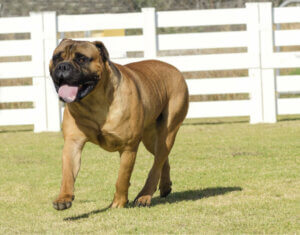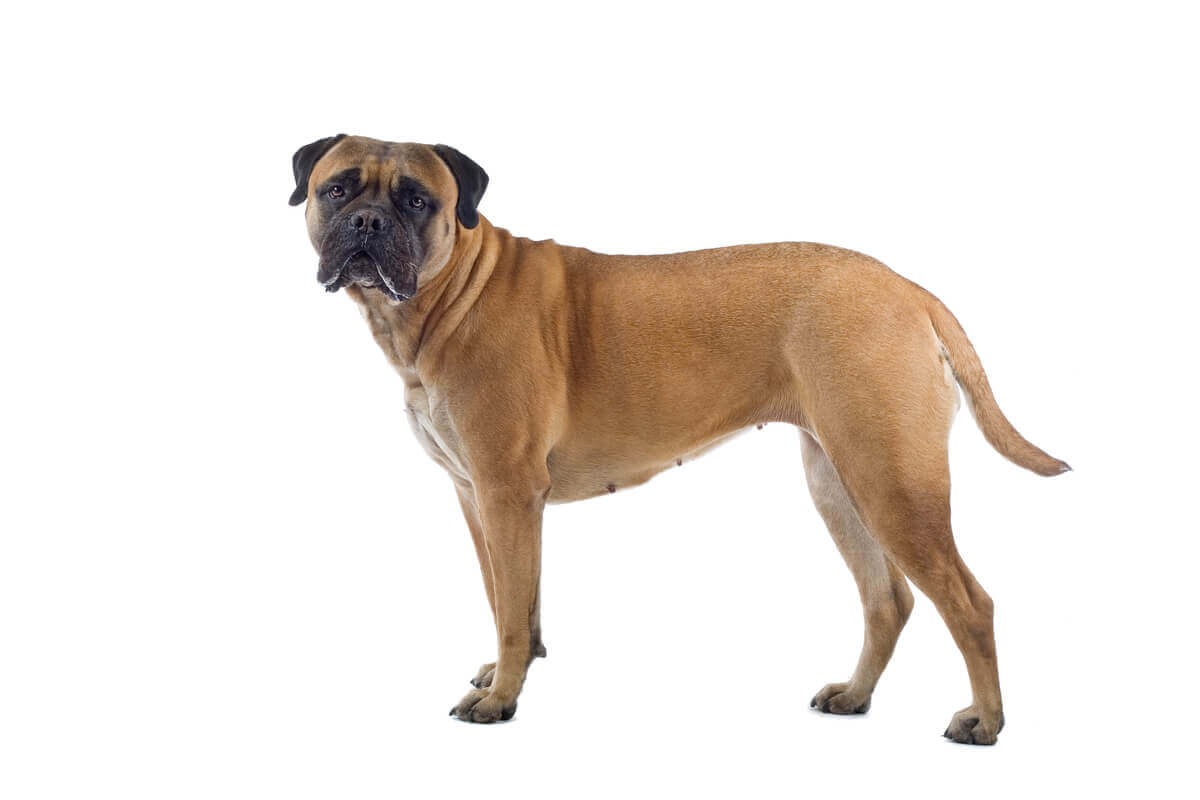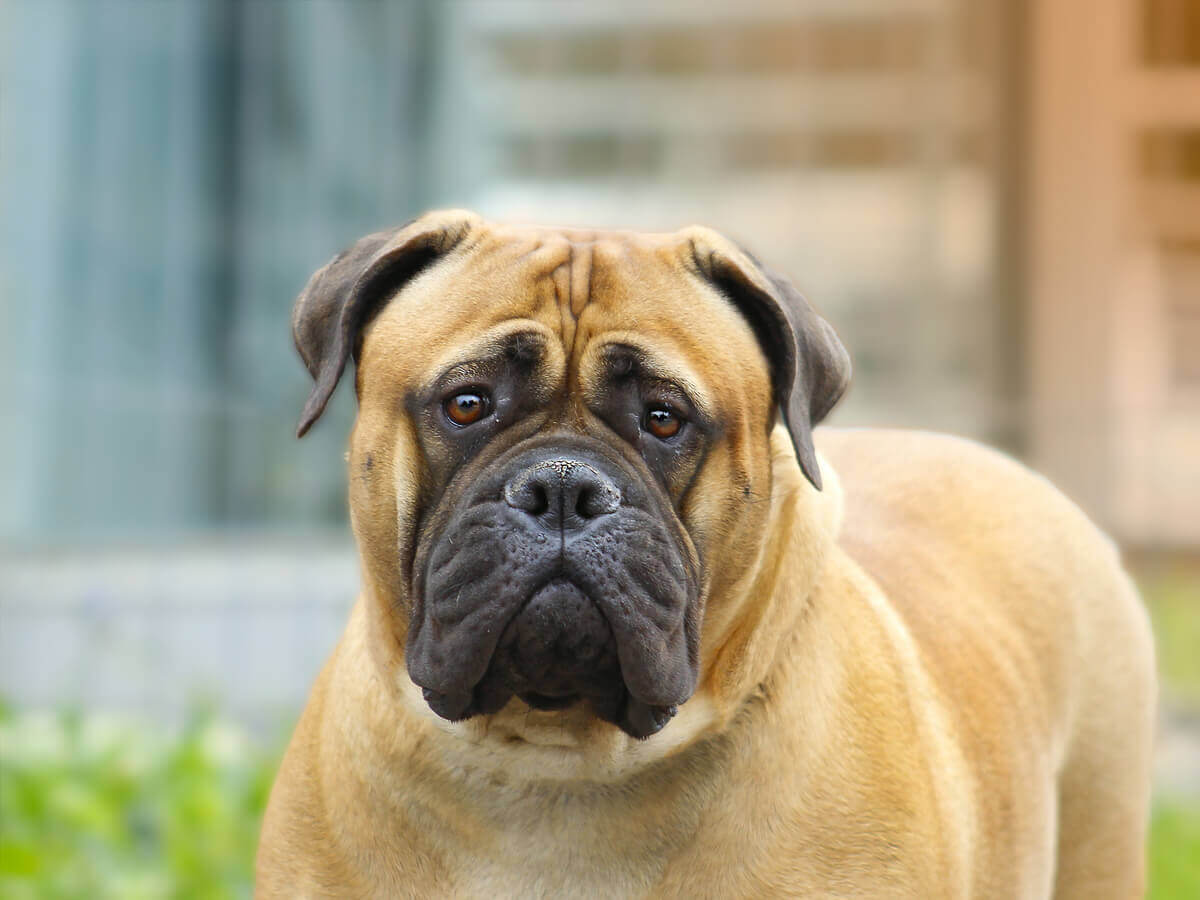The Characteristics and Care of the Bullmastiff

The Bullmastiff is a dog breed of English origin, created at the end of the 19th century. This striking variant of domestic dog comes from the crossbreeding of the old English Mastiff and the Bulldog, as its name suggests. It’s a large, strong, and intelligent dog, but, at the same time, it’s sweet and affectionate with all members of the family. Like any other dog, it needs basic education and training to get along well with and live alongside humans. Here, we’ll tell you everything you need to know about the care of the Bullmastiff.
The Bullmastiff, a guard dog
This breed has always been used as a guard dog. This is because it used to live with the rangers of the country estates, and they helped them to catch poachers. The Bullmastiff is a large dog, about 26 inches tall and weighing about 110 pounds. Males can reach up to about 130 pounds.
It has a strong and robust constitution, of symmetrical proportions. It has a broad and deep chest and a short and straight back that gives it a compact appearance. The tail is straight with a high setting, broad at the base and thinner at the tip.
As for the head of this dog, it’s wide and has a short muzzle, with folds, and hazel eyes. Its small ears fold in a “v” shape and are darker in color than the rest of the body.
Its coat can be brindle, fawn, or red – usually in light shades. It has a black mask that’s characteristic of the breed and may sometimes have a white spot on the chest. The coat is short and hard to the touch, smooth and close to the body – it sheds lightly and is very easy to maintain.

Affectionate with the family, but wary of strangers
The Bullmastiff is an intelligent and observant dog that’s affectionate with all members of the family. However, it’s wary of strangers, and its calm and sweet attitude can change in the presence of people it doesn’t know. It’s a brave, alert, and faithful dog that’s active and it has great endurance.
Good socialization, moderate exercise, and training are three basic aspects to life with this breed in the family. If the puppy has exposure to all kinds of people and situations, it may be less distrustful with visitors and people it doesn’t know as an adult.
The Bullmastiff isn’t considered a potentially dangerous breed, despite its appearance. However, it’s best to offer it a good education to avoid problems with aggressiveness towards strangers.
The most common diseases of the Bullmastiff
The life expectancy of Bullmastiffs is between 8 and 10 years of age on average. It’s a healthy breed in general, but certain diseases having to do with its genetics may appear. Having said that, the most common diseases of this breed are the following:
- Allergies
- Gastric dilatation
- Cancer: Hemangiosarcoma, lymphoma, mastocytoma, and osteosarcoma
- Heart problems: Murmurs, subaortic stenosis, and cardiomyopathy
- Ocular problems: Entropion and progressive retinal atrophy
- Hypothyroidism
- Renal problems
- Musculoskeletal problems: Hip dysplasia, elbow dysplasia, hypertrophic osteodystrophy, osteochondritis dissecans, and panosteitis
One of the main objectives of its breeders is to reduce the frequency in which these diseases occur. However, the fact that these are the most common pathologies in the Bullmastiff doesn’t mean that they’re always going to suffer from them. Many of them can be prevented with good care and proper feeding.
The care of the bullmastiff: Tips
As we’ve already mentioned, proper socialization is essential in order to avoid behavioral problems associated with its guardian instinct. We offer the following tips to keep your Bullmastiff happy and healthy:
- Avoid overfeeding the canine and offer good quality food: A good diet is an investment in your dog’s health, so choose high-end feed or a proper BARF diet program. Always feed the animal based on its ideal weight and pay special attention to its nutrition during the puppy’s growth stage.
- Moderate exercise: To keep the dog at a healthy weight and with strong muscles and bones, you should walk it daily. The Bullmastiff is a very hardy dog and will tolerate long walks rather better than energetic exercise. You should also control exercise during growth to avoid musculoskeletal problems.
- Go to the vet regularly: Vaccinations and check-ups at the vet are very important to keep track of the animal’s health and detect diseases in time, especially when the animal reaches a certain age.
- Protect it against parasites: Good hygiene and the use of external and internal antiparasitics prevent multiple diseases such as leishmaniasis.

The Bullmastiff is a dog breed of English origin, created at the end of the 19th century. This striking variant of domestic dog comes from the crossbreeding of the old English Mastiff and the Bulldog, as its name suggests. It’s a large, strong, and intelligent dog, but, at the same time, it’s sweet and affectionate with all members of the family. Like any other dog, it needs basic education and training to get along well with and live alongside humans. Here, we’ll tell you everything you need to know about the care of the Bullmastiff.
The Bullmastiff, a guard dog
This breed has always been used as a guard dog. This is because it used to live with the rangers of the country estates, and they helped them to catch poachers. The Bullmastiff is a large dog, about 26 inches tall and weighing about 110 pounds. Males can reach up to about 130 pounds.
It has a strong and robust constitution, of symmetrical proportions. It has a broad and deep chest and a short and straight back that gives it a compact appearance. The tail is straight with a high setting, broad at the base and thinner at the tip.
As for the head of this dog, it’s wide and has a short muzzle, with folds, and hazel eyes. Its small ears fold in a “v” shape and are darker in color than the rest of the body.
Its coat can be brindle, fawn, or red – usually in light shades. It has a black mask that’s characteristic of the breed and may sometimes have a white spot on the chest. The coat is short and hard to the touch, smooth and close to the body – it sheds lightly and is very easy to maintain.

Affectionate with the family, but wary of strangers
The Bullmastiff is an intelligent and observant dog that’s affectionate with all members of the family. However, it’s wary of strangers, and its calm and sweet attitude can change in the presence of people it doesn’t know. It’s a brave, alert, and faithful dog that’s active and it has great endurance.
Good socialization, moderate exercise, and training are three basic aspects to life with this breed in the family. If the puppy has exposure to all kinds of people and situations, it may be less distrustful with visitors and people it doesn’t know as an adult.
The Bullmastiff isn’t considered a potentially dangerous breed, despite its appearance. However, it’s best to offer it a good education to avoid problems with aggressiveness towards strangers.
The most common diseases of the Bullmastiff
The life expectancy of Bullmastiffs is between 8 and 10 years of age on average. It’s a healthy breed in general, but certain diseases having to do with its genetics may appear. Having said that, the most common diseases of this breed are the following:
- Allergies
- Gastric dilatation
- Cancer: Hemangiosarcoma, lymphoma, mastocytoma, and osteosarcoma
- Heart problems: Murmurs, subaortic stenosis, and cardiomyopathy
- Ocular problems: Entropion and progressive retinal atrophy
- Hypothyroidism
- Renal problems
- Musculoskeletal problems: Hip dysplasia, elbow dysplasia, hypertrophic osteodystrophy, osteochondritis dissecans, and panosteitis
One of the main objectives of its breeders is to reduce the frequency in which these diseases occur. However, the fact that these are the most common pathologies in the Bullmastiff doesn’t mean that they’re always going to suffer from them. Many of them can be prevented with good care and proper feeding.
The care of the bullmastiff: Tips
As we’ve already mentioned, proper socialization is essential in order to avoid behavioral problems associated with its guardian instinct. We offer the following tips to keep your Bullmastiff happy and healthy:
- Avoid overfeeding the canine and offer good quality food: A good diet is an investment in your dog’s health, so choose high-end feed or a proper BARF diet program. Always feed the animal based on its ideal weight and pay special attention to its nutrition during the puppy’s growth stage.
- Moderate exercise: To keep the dog at a healthy weight and with strong muscles and bones, you should walk it daily. The Bullmastiff is a very hardy dog and will tolerate long walks rather better than energetic exercise. You should also control exercise during growth to avoid musculoskeletal problems.
- Go to the vet regularly: Vaccinations and check-ups at the vet are very important to keep track of the animal’s health and detect diseases in time, especially when the animal reaches a certain age.
- Protect it against parasites: Good hygiene and the use of external and internal antiparasitics prevent multiple diseases such as leishmaniasis.

All cited sources were thoroughly reviewed by our team to ensure their quality, reliability, currency, and validity. The bibliography of this article was considered reliable and of academic or scientific accuracy.
- Federation Cynologique Internationales. Bullmastiff
- The American Bullmastiff Association. Common Diseases & Conditions.
This text is provided for informational purposes only and does not replace consultation with a professional. If in doubt, consult your specialist.








